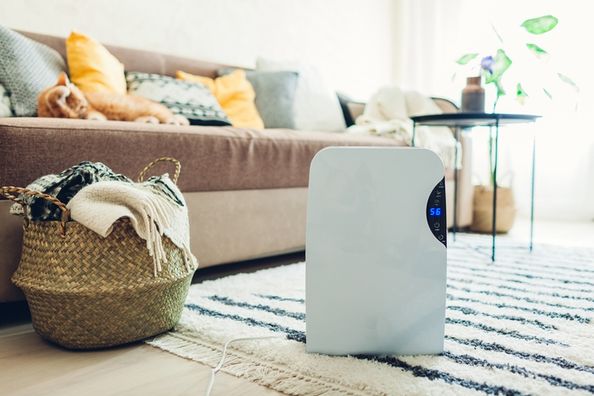During warmer weather, natural ventilation from open windows and doors helps maintain the air quality indoors. As temperatures drop, windows and doors are kept closed and we rely on furnaces to stay warm. The resulting lack of fresh air can have a negative impact on the air quality in your home.
As your home’s air quality is reduced, you may develop upper respiratory symptoms such as coughing, headaches, eye irritation, nasal congestion or a sore throat. If you have asthma, you may have more frequent or severe attacks. Fortunately, there are ways you can improve the air quality in your home, such as cleaning air ducts, replacing the filters in your furnace and using air purifiers, dehumidifiers or humidifiers. Board-certified allergy, asthma and immunology specialist, Dr. Andrey Leonov, shares tips on how to maintain good air quality in your home this winter.
There are several types of pollutants that can affect the air quality in your home. Common culprits include chemicals from cleaning products, household appliances including your fireplace, hot water heater, furnace, dryer and stove, as well as mold, dust and dander from pets. These pollutants can accumulate over time and affect your health. To maintain the air quality in your home, we recommend:
Keeping up with cleaning
Changing sheets and towels regularly, as well as vacuuming (using a vacuum with a HEPA filter) once a week, helps eliminate pollutants that are brought into your home.
Checking humidity levels
Dehumidifiers and humidifiers can help maintain the recommended humidity level within your home. Ideally, humidity levels should be between 30 to 50 percent. You can check the humidity level in your home using a hygrometer, a gauge that looks like a thermometer that can be purchased at most hardware stores.
Low humidity causes the air in your home to become dry. This is more common during cold weather because cold air can’t hold as much water vapor as warm air. Without proper moisture in the air, your health (and home) can suffer. You may experience symptoms including dryness of your eyes, nose, skin and throat. Lower humidity levels can also impact your home, damaging wood and drywall over time.
You can increase the humidity level in your home by using a humidifier. Humidifiers utilize a filter that absorbs water and a fan to circulate the moisture from the filter into the air. They come in a variety of types and sizes. Choosing the right humidifier will depend on your personal preference as well as the square footage of your space. It is important to keep your humidifier clean and to change the filters regularly.
If you have elevated moisture in your home, a dehumidifier can help remove the excess moisture from the air. This is important because damp air can lead to mold and bacteria growth. Exposure to high amounts of mold can cause symptoms including coughing, eye and throat irritation, skin rashes and sneezing.
You should consider a dehumidifier if you notice:
- Signs of excess moisture (wet stains on your walls, ceiling or condensation on windows)
- Stuffy rooms
- A musty odor
- Visible mold
Set up your dehumidifier in areas of your house prone to moisture, such as basements, bathrooms and laundry areas.
Use natural cleaning products
Many cleaning products contain chemicals that can affect the air quality in your home. Using products that are non-toxic and contain natural ingredients can reduce the amount of pollutants released into the air.
Clean your air ducts
Air is circulated throughout your home by your heating and cooling system. Cleaning your air ducts helps to remove dust, mold and other allergens that have accumulated. Furnace air filters should also be changed every two to three months.
Purify your air
If you are allergic to environmental pollutants like dust, mold and animal dander, an air purifier can help trap and remove them from the air. Air purifiers utilize a filter (or multiple filters) and fan that take in air, capture pollutants and other particles, then release the filtered air back into your home. For the best results, place an air purifier in commonly used areas in your home. While air purifiers won’t totally eliminate allergens, they can help reduce them.
Without the regular flow of fresh air provided by open doors and windows, allergens can become trapped inside during the winter. Whenever possible, even during colder months, try to open windows, even just for a few minutes, to let fresh air in. Taking steps to improve your home’s air quality can have a positive impact on your health, including reduced allergy symptoms and asthma attacks. Learn more about our Allergy, Asthma & Immunology team or schedule an appointment with them online.
Health Topics:








